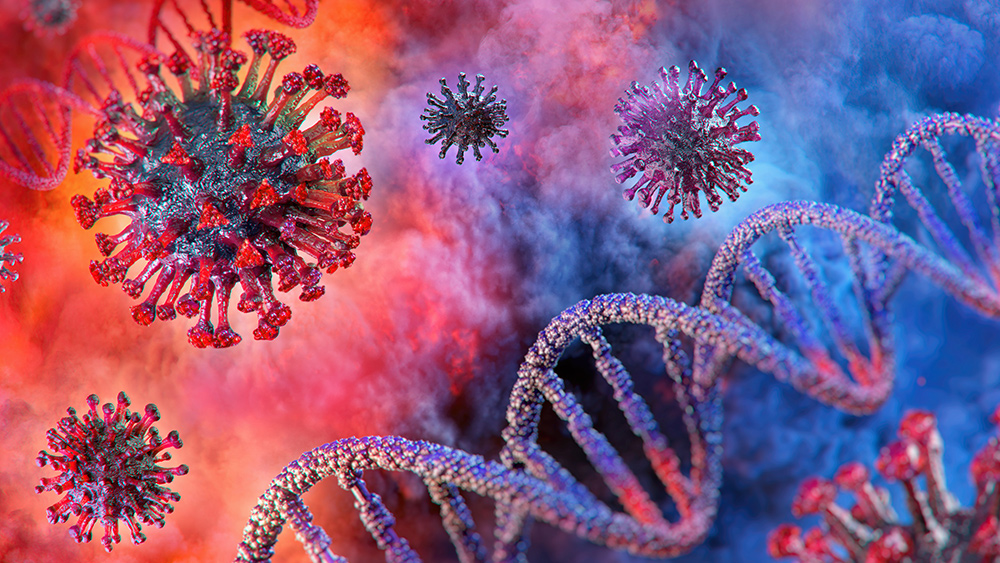STUDY: Covid face masks contain dangerous levels of titanium dioxide that are easily inhaled
03/03/2022 / By Ethan Huff

New research published in the Nature journal Scientific Reports reveals that Wuhan coronavirus (Covid-19) “face masks” are loaded with toxic levels of titanium dioxide (TiO2) that “systematically [exceed] the acceptable exposure level” of what is considered “safe.”
A suspected human carcinogen, TiO2, when inhaled as fiber-grade nanoparticles, is not good for human health. And yet this is the kind of TiO2 that is abundantly present in your standard Fauci Flu nose-and-mouth veil.
“STEM-EDX analysis on sections of a variety of single use and reusable face masks visualised agglomerated near-spherical TiO2 particles in non-woven fabrics, polyester, polyamide and bi-component fibers,” the study found.
“Median sizes of constituent particles ranged from 89 to 184 nm, implying an important fraction of nano-sized particles (<?100 nm). The total TiO2 mass determined by ICP-OES ranged from 791 to 152,345 µg per mask.”
The “acceptable” level of TiO2 for inhalation is 3.6 µg. All of the face masks tested, however, contained far, far more than this, averaging between 17 to 4394 µg depending on the brand. (Related: Face masks also deprive a person of oxygen, which is especially harmful in developing children.)
Separate study found that face masks are loaded with heavy metals, plastics
An earlier study published in the journal Water Research found that Fauci face masks also contain other toxins such as lead, cadmium, mercury and all sorts of plastics.
“The toxicity of some of the chemicals found and the postulated risks of the rest of the present particles and molecules, raises the question of whether [disposable face masks] are safe to be used on a daily basis and what consequences are to be expected after their disposal into the environment,” that study reads.
Sadly, the Nature study included an obligatory genuflection at the end subscribing to the notion that wearing a face mask is still important and beneficial, despite the presence of toxic substances.
The paper claims that the “science” behind wearing a face mask is “unquestionable,” even if breathing in all the poisons it contains damages your health.
In the comment section at the Daily Sceptic, someone explained that in order for the Nature study to even get published in the first place, the researchers had to include the caveat that wearing a face mask is still necessary despite the risks.
“However, it makes no difference to the outcome if the authors are paying lip-service or believe what they say: another scientific myth is perpetuated,” this same person added.
“It’s not only if you want to get published,” wrote someone else. “We are now in a world where many things are unquestionable – if you want to keep your job, your house and your freedom.”
Another quoted scientist Richard Feynman who said that “it isn’t the questions that cannot be answered that bother me; it is the answers that cannot be questioned.”
It should also be noted that the Nature journal has a reputation for pushing censorship and political correctness, so it is no surprise that the mask study was crafted the way it was.
“Nothing is ‘unquestionable’ in science, other than the basic axioms in mathematics and logic,” pointed out another person. “Newton’s laws are pretty good and for hundreds of years most people thought they were 100% true in all circumstances but it turns out they were not.”
Many others agreed with these sentiments, with one also suggesting that the communitarian idea of wearing a mask for the “greater good,” even if it harms you personally – the same is true about the “vaccines” – makes it a necessity.
“Chopping up one healthy person for parts can save many lives!” joked someone else.
More related news can be found at ChemicalViolence.com.
Sources for this article include:
Submit a correction >>
Tagged Under:
This article may contain statements that reflect the opinion of the author
RECENT NEWS & ARTICLES
BadMedicine.News is a fact-based public education website published by BadMedicine News Features, LLC.
All content copyright © 2019 by BadMedicine News Features, LLC.
Contact Us with Tips or Corrections
All trademarks, registered trademarks and servicemarks mentioned on this site are the property of their respective owners.




















